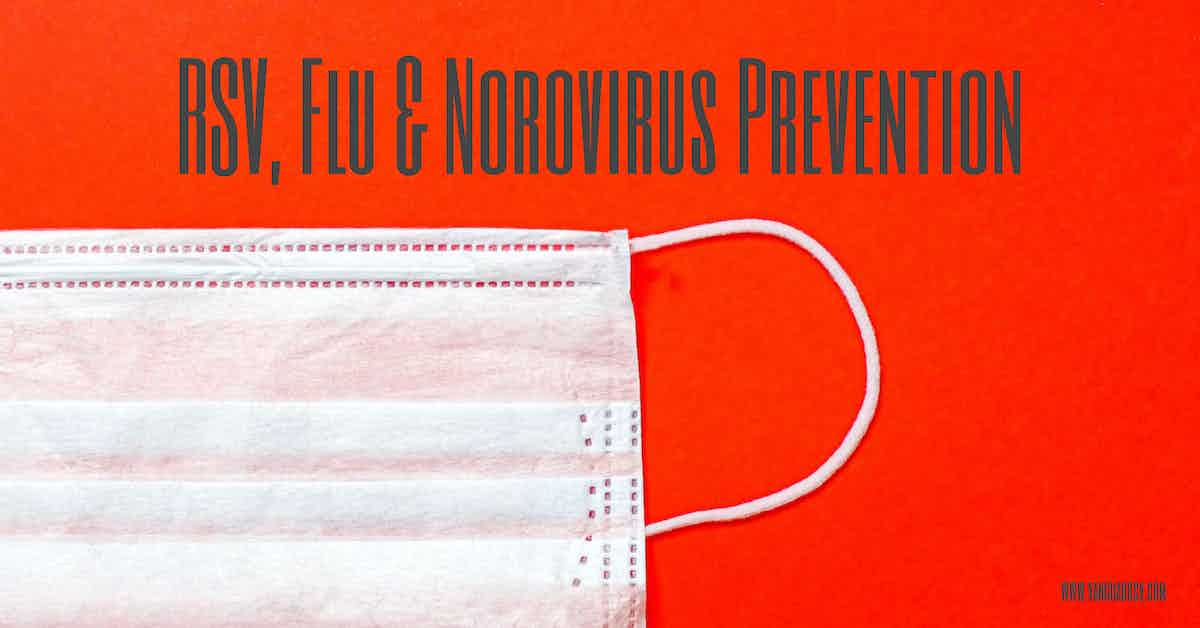Widespread RSV, influenza, and norovirus outbreaks have been reported this year, underscoring the importance of implementing consistent preventative measures designed to enhance occupant health and safety.

RSV, Influenza, and Norovirus Outbreaks
The last few months have seen a sharp increase in seasonal infections.
The U.S. Centers for Disease Control and Preventions FluView data for the 45th week of 2022 reports that 5.8% of hospital visits were for respiratory infection--well above the baseline of 2.5% and considerably higher than previous years.
Additionally, pneumonia, influenza, and COVID-coded deaths for the same week stand at 9.4%--well above the seasonal epidemic threshold of approximately 6%.
Further, according to RSV-NET, hospitalization rates due to RSV infections stand at 22.4 per 100k people on the season--nearly three times the 2021-22 rate (7.5) during the same period.
Finally, the 3-week average for positive norovirus tests currently sits at 6.1%, above the 4.7% during the same period last year.
The Burden of Illness
According to the CDC, the flu has resulted in the following:
- 9 million – 41 million illnesses,
- 140,000 – 710,000 hospitalizations, and;
- 12,000 – 52,000 deaths annually between 2010 and 2020.
Annually, RSV leads to:
- 2.1 million outpatient (non-hospitalization) visits among children younger than five-years-old.
- 58,000-80,000 hospitalizations among children younger than five years old.
- 60,000-120,000 hospitalizations among adults 65 years and older.
- 6,000-10,000 deaths among adults 65 years and older, and;
- 100–300 deaths in children younger than five years old.
And, yearly norovirus infections in the U.S. result in (on average):
- 900 deaths, mostly among adults aged 65 and older.
- 109,000 hospitalizations.
- 465,000 emergency department visits, mainly in young children.
- 2,270,000 outpatient clinic visits annually, mostly in young children, and;
- 19 to 21 million cases of vomiting and diarrhea illnesses.
Seasonal Outbreak Prevention Strategies
Except for COVID, most common seasonal infections are typically transmitted via touch--either directly between people or indirectly from contaminated surfaces--underscoring the importance of good occupant handwashing practices.
Facility restrooms and handwashing stations should be stocked with the following:
- Paper towels.
- Hand soap.
- Hand sanitizer and;
- Touchless fixtures, where practical.
Surface hygiene is also critical to infection prevention.
Disinfecting high-touch germ hotspots with a registered disinfectant and cleaning with soap and water using a microfiber towel or mophead is adequate for maintaining a safe and healthy facility outside of outbreak periods.
Items to consider during outbreaks include:
- Cleaning and disinfection frequencies.
- Product selection and management, and;
- Cleaning tool and equipment selection and maintenance.
Additionally, when cleaning, service providers must take care to prevent spreading contamination further by wearing and correctly handling personal protective equipment, especially:
- Gloves.
- Goggles.
- Respirators.
- Coveralls, and;
- Boots.
Further, facility managers should address how contaminants are introduced into facilities.
The most common route for soil and contaminant introduction into a building is on the soles of occupant shoes--making daily high-outcome floor care one of the most critically overlooked aspects of infection prevention and control.
- Daily sweeping, mopping, and vacuuming is a must.
- Placing walkway and entry matting at primary ingress and egress points and along main thoroughfares will significantly reduce the amount of soil introduced and transferred through a building.
Air quality controls will also regulate and prevent the introduction and spread of airborne microbes by circulating the air in a room multiple times per hour and dispersing harmful particles.
Using high-grade HEPA filters and commercial-grade air purifiers can further reduce harmful particulate matter from the air and help improve overall facility safety and occupant health.
References & Resources
- Weekly U.S. Influenza Surveillance Report
- Norovirus for the US (3-week average)
- Burden of Norovirus Illness in the U.S.
- Disease Burden of Flu
- RSV-NET Interactive Dashboard
- RSV Research & Surveillance
Takeaway
Widespread outbreaks have been reported for multiple pathogens across the U.S.
Implementing early preventative strategies that focus on handwashing with soap and water, targeted hotspot disinfection, and enhanced daily cleaning protocols will protect vulnerable demographics from infection and prevent academic and business performance and attendance challenges associated with seasonal illness.
Onboarding and managing the requisite labor and material resources in-house will likely prove cost-prohibitive for many organizations.
Outsourcing is a proven method for onboarding highly in-demand cleaning and disinfection services and experience for a fraction of the price of maintaining a similar service in-house.
If you would like more information regarding the effectiveness of high-performance infection prevention and control measures, or if you would like to schedule a free, no-obligation on-site assessment of your facility's custodial needs, contact us today for a free quote!
In Bakersfield, CA, call (661) 437-3253
In Fresno, CA, call (559) 206-1059
In Valencia, CA, or Santa Clarita, CA, call (661) 437-3253
In Palmdale, CA, or Lancaster, CA, call (661) 371-4756

